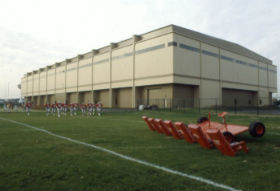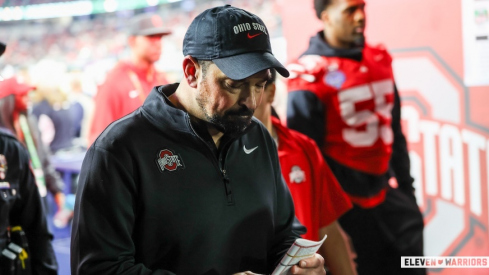
Members of the Alpha Psi Omega Fraternity rang the Victory Bell at Ohio Stadium this past Sunday, signifying the end of Ohio State's 400th Commencement. Not only did the bell represent the end of another graduation, it would be the last June ceremony in Ohio Stadium.
Starting this coming year (Fall 2012), The Ohio State University will be switching to a semester system. Although this information has become common knowledge to those tied to the university, many do not realize the overall affect the change has on the football program, each individual athlete and the Ohio State students.
Since the Woody Hayes days, the football program has had the most luxurious of summer's end schedules with fall quarter classes at OSU not starting until late September. Over the last 10 years, classes have begun, on average, around September 22nd, the latest start date of any school in the Big Ten.
This last year, fall classes started September 21st for students and student-athletes meaning the Buckeyes played three football games before any player even stepped foot into a classroom.
Although NCAA still limits mandatory practice hours to 20, players were able to spend countless hours studying film, working out, conditioning and preparing on their own, sans coaches, without ever having to worry about being a student that goes along with being an "student-athlete". Freshman had extra time to adjust to the demands of college football and athletes could focus all of their energy on the front quarter of the football schedule.
This coming season, everything is about to change and Urban Meyer will not have the same luxury that once was.
University of Michigan classes have historically begun right after Labor Day and started this last year on September 6th, meaning Ohio State football had more than two additional weeks of a football-only atmosphere before starting classes of their own.
With the average student taking 15 credit hours per quarter or 16 hours per semester, that's time the players would use to prepare for the upcoming season.
In the last decade, Ohio State has gone 26-4 during their first 3 games of the season losing to Miami-FL last season, USC twice in '08 and '09, and Texas in '05. However, it is not certain that the Buckeyes had any advantage by having that extra time advantage.
The Buckeyes had extremely tight games with what should have been pushovers in Toledo this past year, Navy in '09, Ohio U in '08, Marshall (last second Nugent FG) in '04, North Carolina State in'04 and '03, and San Diego State in '03.
 Will semesters change the team's voluntary hours
Will semesters change the team's voluntary hoursWhen the season opens up this year, each student-athlete will have already had 8 full days of class, very different than what the upper-classmen will be used to.
There are, conversely, many advantages and disadvantages to the incoming situation and semesters affect the entire athletic department, not just football.
Ohio State athletics spokesman Jerry Emig told The Lantern in an email:
“Under the quarter system, OSU student-athletes in the winter and spring sports could not begin this instruction until the quarter began, leaving them at a considerable disadvantage to other schools, whose student-athletes in those sports were able to start the first day of their fall semesters.”
So, with all sports considered, the move could be beneficial. Here's my break down of the pros and cons with football as the top priority:
CONS
- Less "free-time" for football team members to prepare for the season without the worry of classes, homework, quizzes and exams for 3-4 weeks. Countless extra hours of studying film, conditioning, and team building will have to be balanced out with school work. The focus was entirely on football for weeks into the season.
- Ticket allocation has to be changed. In the past, students were not on campus until mid-September (upper class) or the week of classes (freshmen). Now, students will be on campus for the entire season demanding football tickets for those out of conference games. Alumni were allotted 160K tickets in past seasons, many of them for the games prior to Big Ten play, since the students were not yet demanding tickets. The athletic department has made changes and will reduce student tickets per game from 30,000 to 28,700 and faculty tickets from 15,000 to 13,700. The school will offer students both a four-game package and an all-eight home games package.
PROS
- Those football players with NFL aspirations will benefit as a rule limits players to one rookie camp until class graduation. This rule has made it extremely difficult for those players in the past, especially those in jeopardy of making a team.
- Basketball players leaving early for the NBA will impact the program less by not costing the program valuable APR points. APR (academic progress rate) is calculated by each student-athlete receiving athletically related financial aid earns one retention point for staying in school and one eligibility point for being academically eligible. A team’s total points are divided by the points possible and then multiplied by one thousand to equal the team’s Academic Progress Rate score. With school ending sooner in the spring, leaving early will not cost the school the same way it has been.
For the athletes themselves, specifically for sports besides football, the change seems to be only positive.
Players will now have more time for classes with less frequent exams, more time for tutoring, and more with classes lasting 16 weeks as opposed to 10 in the quarter system.
Grayson Overman, a member of the volleyball team told The Lantern:
“I’m pretty stoked for (the change), it’s going to be a lot slower pace which will be a break and might make volleyball more exciting.”
The student-athletes will indeed feel the slower pace of the semester system but will need to understand that the semester system can be less forgiving to those who become ineligible. Opposed to the quarter system, if an athlete is ineligible for the fall semester, he or she will have to wait until the start of the spring quarter to become eligible. On the quarter system, athletes that have a bad quarter and become ineligible will be able to make it up the following quarter, unlike semesters.
The installation of the semester system will change the overall dynamic of Ohio State's athletic program. It will improve many facets of being a student-athlete at OSU, but changing the historic (and ironic) schedule that allowed the football team to ease into the season. As Urban Meyer has never had the luxury of starting late in September, I think he'll be able to handle the challenge.

